Topsham, Devon
EX3 0QH
Tel: 01392 878 200
Email: info@dartsfarm.co.uk
- Gallery
- Recipes & Blog
- Opening Hours
- Contact Us
- My Account
Darts Farm
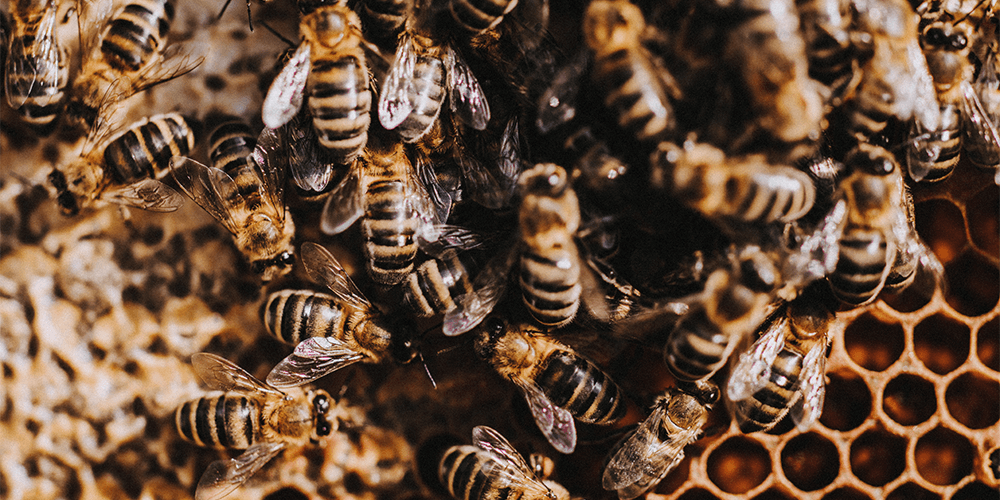
Supporting Pollinators in your Garden
Posted in The Farm, Lifestyle on 19 May 2022
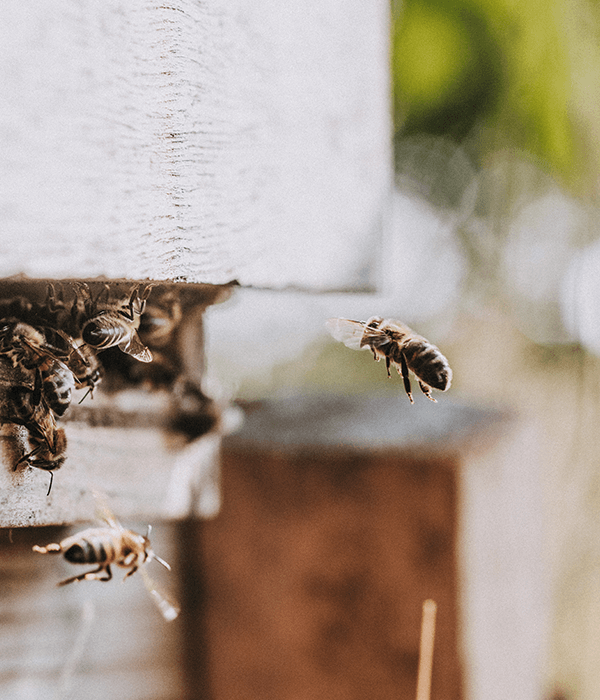 Here on our farm and vineyards, we are proud to have our own hives, tended to by our devoted bee keeper Phillip. Bees are crucial for pollinating our crops, pastures & hedgerows, sustaining our local ecosystem & biodiversity and helping the land around us flourish.… not to mention, 1/3 of the world’s food production and 90% of our wild crops depends on bees and pollination. They are a vital part of our world and are facing an alarming decline – the prospect of a world without them is terrifying.
Here on our farm and vineyards, we are proud to have our own hives, tended to by our devoted bee keeper Phillip. Bees are crucial for pollinating our crops, pastures & hedgerows, sustaining our local ecosystem & biodiversity and helping the land around us flourish.… not to mention, 1/3 of the world’s food production and 90% of our wild crops depends on bees and pollination. They are a vital part of our world and are facing an alarming decline – the prospect of a world without them is terrifying.
There are plenty of ways to support bees and other important pollinators from your own garden, here are a few of our top tips...
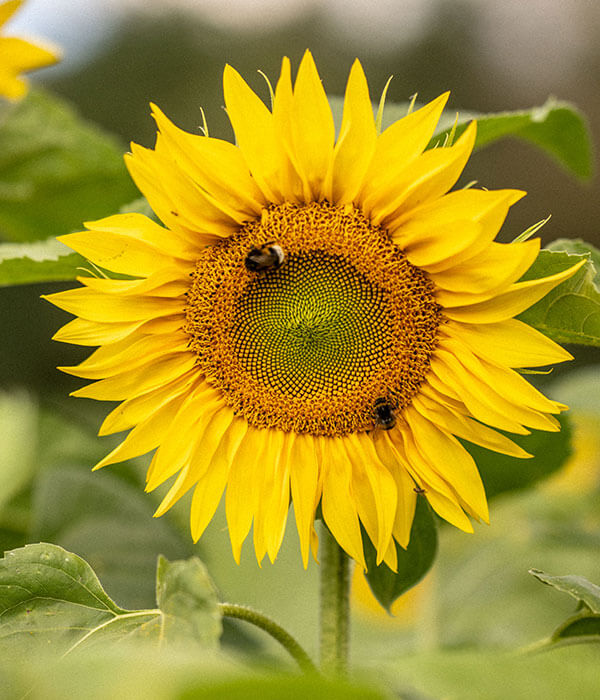 Plant native honey plants
Plant native honey plants
Planting a bee friendly garden is something anyone can do and provides vital nectar and pollen for our pollinators.
In order to best support different pollinators throughout the different seasons, it is important to plant a range of flowers in your garden, so that bees have access to nectar from March to October. To support pollinators for the whole year, aim to have at least two nectar or pollen-rich plants in flower during winter. Plants like winter honeysuckle and winter clematis are perfect for the job.
For small areas, try herbs and aromatic plants such as; basil, thyme, sage and lemon balm – not only are these perfect for pollinators, but make great additions to your cooking – with zero food miles!
When it comes to flowers, bees love blue and violet the best, from fragrant lavender to buddleia (the butterfly bush)… be sure to choose a sunny spot when planting to encourage nectar rich flowers and attract bees & butterflies. For long-tongued bees, such as the garden bumble bee, Tubular-shaped flowers, such as foxgloves, are brilliant for long-tongued bees like the garden bumble bee. Be sure to leave plenty of space around your foxglove when planting as they produce seeds and new seedlings will grow.
Trees and shrubs produce much higher quantities of pollen and nectar; making them perfect for larger areas; from wild cherry & crab apple trees to rose bushes.
Here on the farm, it’s not just our wildflowers, sunflowers & trees that are great for our pollinators; the also love crops such as clover and veggies like pumpkins & cucumber!
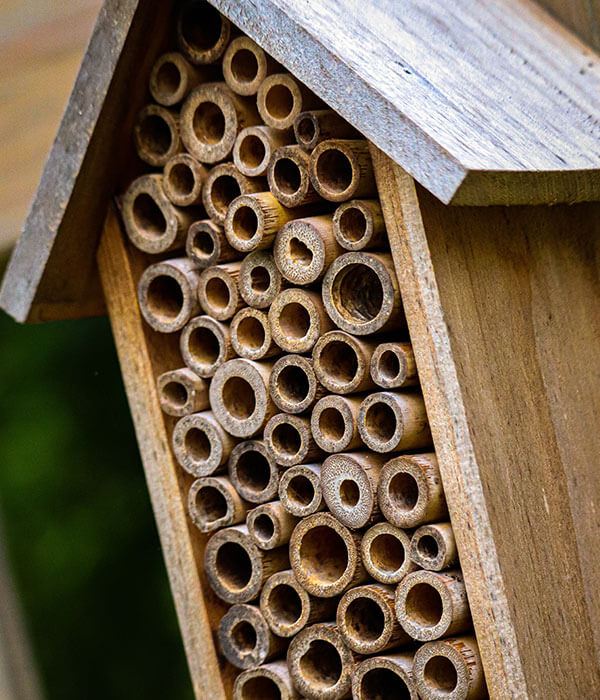 Make your own nest box for solitary bees
Make your own nest box for solitary bees
Did you know that, with the exception of honeybees, most bees are solitary creatures? 70% of solitary bees live underground, while 30% live in holes inside of trees or hollow stems. You can create your own nest box at home using the following steps...
1) Choose a nesting material: You can make a nest box for bees out of wood or hollow plant stalks (such as bamboo or cane). Or you can use a combination of both.
2) Drill the wood: To attract various species, drill holes of different dimensions, i.e. with a diameter of 4–10 mm and a depth of up to 10 cm. If using bamboo or cane, make your nest box by cutting stalks at least 10 cm in length.
3) Construct the nest box: Assemble the wood pieces to create the desired shape, putting the holes on the outside of the box so the bees can enter. A nest box can take the shape of a little house or shapes such as a circle. We would suggest adding a roof to protect it from rain!
4) Put up the nest box: It is best to put the nest box up in spring, when the greatest number of species is most active. We should place or hang it in a warm, sunny spot, protected from rain (windowsill, garden shed, terrace, balcony etc.). The optimal height is one to two metres above the ground; the nest can also be placed higher up (for example on a balcony), but fewer bees will probably use it.
5) Attract bees with nectar plants: Use the recommendations above to create a vivid floral and the bees will check into your hotel themselves. The first year their numbers may be small, but should increase over time. Solitary bees are wild animals and, apart from a safe nest, do not require any special attention given a suitable habitat.
Create a bee bath
Bees work up quite a thirst foraging and collecting nectar – when the sun is shining you will always see them having a drink from the pond on our Nature Trail.
To create a bee bath at home, fill a shallow bird bath or bowl with clean water, and arrange pebbles and stones inside so that they break the water’s surface. Bees will land on the stones and pebbles to take a long, refreshing drink.
Be part of our community
Tags
- Food Hall
- Recipes
- The Farm
- News
- Awards
- Lifestyle
- Fitness & Wellbeing
- Food & Drink
- Seasonality
- Charity
- Supporting Local
- The Fish Shed
- Butchers
- The Flower Shack
- Energy Hair
- Winter Recipe
- Autumn Recipe
- Spring Recipe
- Summer Recipe
- The Farm Table
- November 2017 (1)
- July 2018 (1)
- August 2018 (1)
- August 2018 (1)
- September 2018 (1)
- September 2018 (1)
- September 2018 (1)
- September 2018 (1)
- October 2018 (1)
- October 2018 (1)
- November 2018 (1)
- November 2018 (1)
- November 2018 (1)
- December 2018 (1)
- January 2019 (1)
- January 2019 (1)
- March 2019 (1)
- March 2019 (1)
- May 2019 (1)
- May 2019 (1)
- May 2019 (1)
- May 2019 (1)
- May 2019 (1)
- May 2019 (1)
- June 2019 (1)
- June 2019 (1)
- June 2019 (1)
- June 2019 (1)
- June 2019 (1)
- June 2019 (1)
- July 2019 (1)
- July 2019 (1)
- July 2019 (1)
- July 2019 (1)
- August 2019 (1)
- September 2019 (1)
- September 2019 (1)
- October 2019 (1)
- November 2019 (1)
- November 2019 (1)
- November 2019 (1)
- December 2019 (1)
- December 2019 (1)
- December 2019 (1)
- December 2019 (1)
- December 2019 (1)
- December 2019 (1)
- December 2019 (1)
- December 2019 (1)
- December 2019 (1)
- December 2019 (1)
- December 2019 (1)
- January 2020 (1)
- January 2020 (1)
- January 2020 (1)
- January 2020 (1)
- January 2020 (1)
- January 2020 (1)
- January 2020 (1)
- January 2020 (1)
- January 2020 (1)
- January 2020 (1)
- January 2020 (1)
- January 2020 (1)
- January 2020 (1)
- January 2020 (1)
- January 2020 (1)
- January 2020 (1)
- January 2020 (1)
- January 2020 (1)
- January 2020 (1)
- January 2020 (1)
- January 2020 (1)
- January 2020 (1)
- January 2020 (1)
- February 2020 (1)
- February 2020 (1)
- February 2020 (1)
- February 2020 (1)
- February 2020 (1)
- February 2020 (1)
- February 2020 (1)
- February 2020 (1)
- February 2020 (1)
- February 2020 (1)
- March 2020 (1)
- March 2020 (1)
- March 2020 (1)
- March 2020 (1)
- March 2020 (1)
- March 2020 (1)
- April 2020 (1)
- April 2020 (1)
- April 2020 (1)
- April 2020 (1)
- April 2020 (1)
- April 2020 (1)
- April 2020 (1)
- April 2020 (1)
- April 2020 (1)
- April 2020 (1)
- April 2020 (1)
- April 2020 (1)
- May 2020 (1)
- May 2020 (1)
- May 2020 (1)
- May 2020 (1)
- May 2020 (1)
- May 2020 (1)
- May 2020 (1)
- June 2020 (1)
- June 2020 (1)
- June 2020 (1)
- June 2020 (1)
- June 2020 (1)
- June 2020 (1)
- June 2020 (1)
- June 2020 (1)
- July 2020 (1)
- July 2020 (1)
- July 2020 (1)
- July 2020 (1)
- July 2020 (1)
- July 2020 (1)
- August 2020 (1)
- August 2020 (1)
- August 2020 (1)
- August 2020 (1)
- August 2020 (1)
- August 2020 (1)
- August 2020 (1)
- September 2020 (1)
- September 2020 (1)
- September 2020 (1)
- September 2020 (1)
- September 2020 (1)
- September 2020 (1)
- September 2020 (1)
- October 2020 (1)
- October 2020 (1)
- October 2020 (1)
- October 2020 (1)
- October 2020 (1)
- November 2020 (1)
- November 2020 (1)
- December 2020 (1)
- December 2020 (1)
- December 2020 (1)
- January 2021 (1)
- January 2021 (1)
- January 2021 (1)
- February 2021 (1)
- February 2021 (1)
- March 2021 (1)
- April 2021 (1)
- May 2021 (1)
- May 2021 (1)
- May 2021 (1)
- May 2021 (1)
- May 2021 (1)
- June 2021 (1)
- June 2021 (1)
- June 2021 (1)
- June 2021 (1)
- July 2021 (1)
- July 2021 (1)
- July 2021 (1)
- July 2021 (1)
- July 2021 (1)
- August 2021 (1)
- August 2021 (1)
- August 2021 (1)
- August 2021 (1)
- September 2021 (1)
- September 2021 (1)
- September 2021 (1)
- September 2021 (1)
- October 2021 (1)
- October 2021 (1)
- December 2021 (1)
- December 2021 (1)
- December 2021 (1)
- January 2022 (1)
- January 2022 (1)
- January 2022 (1)
- January 2022 (1)
- February 2022 (1)
- February 2022 (1)
- February 2022 (1)
- February 2022 (1)
- February 2022 (1)
- February 2022 (1)
- February 2022 (1)
- February 2022 (1)
- February 2022 (1)
- February 2022 (1)
- March 2022 (1)
- March 2022 (1)
- March 2022 (1)
- April 2022 (1)
- April 2022 (1)
- May 2022 (1)
- May 2022 (3)
- May 2022 (1)
- May 2022 (1)
- May 2022 (1)
- May 2022 (1)
- May 2022 (1)
- June 2022 (1)
- July 2022 (1)
- July 2022 (1)
- August 2022 (1)
- August 2022 (1)
- September 2022 (1)
- September 2022 (1)
- September 2022 (1)
- September 2022 (1)
- September 2022 (1)
- September 2022 (1)
- October 2022 (1)
- October 2022 (1)
- October 2022 (1)
- October 2022 (1)
- October 2022 (1)
- October 2022 (1)
- October 2022 (1)
- November 2022 (1)
- November 2022 (1)
- November 2022 (1)
- November 2022 (1)
- December 2022 (1)
- December 2022 (1)
- December 2022 (1)
- December 2022 (1)
- December 2022 (1)
- December 2022 (1)
- January 2023 (1)
- January 2023 (1)
- January 2023 (1)
- February 2023 (1)
- February 2023 (1)
- April 2023 (1)
- April 2023 (1)
- April 2023 (1)
- April 2023 (1)
- April 2023 (1)
- April 2023 (1)
- April 2023 (1)
- May 2023 (1)
- May 2023 (1)
- May 2023 (1)
- May 2023 (1)
- June 2023 (1)
- June 2023 (1)
- June 2023 (1)
- June 2023 (1)
- June 2023 (1)
- July 2023 (1)
- July 2023 (1)
- July 2023 (1)
- August 2023 (1)
- August 2023 (1)
- August 2023 (1)
- August 2023 (1)
- August 2023 (1)
- September 2023 (1)
- September 2023 (1)
- October 2023 (1)
- October 2023 (1)
- October 2023 (1)
- November 2023 (1)
- November 2023 (1)
- November 2023 (1)
- November 2023 (1)
- November 2023 (1)
- December 2023 (1)
- December 2023 (1)
- December 2023 (1)
- December 2023 (1)
- January 2024 (1)
- January 2024 (1)
- January 2024 (1)
- January 2024 (1)
- January 2024 (1)
- January 2024 (1)
- January 2024 (1)
- February 2024 (1)
- February 2024 (1)
- February 2024 (1)
- February 2024 (1)
- February 2024 (1)
- February 2024 (1)
- March 2024 (1)
- March 2024 (1)
- March 2024 (1)
- March 2024 (1)
- March 2024 (1)
- March 2024 (1)
- April 2024 (1)
- April 2024 (1)
- April 2024 (1)
- April 2024 (1)
- April 2024 (1)
- May 2024 (1)
- June 2024 (1)
- July 2024 (1)
- July 2024 (1)
- July 2024 (1)
- July 2024 (1)
- August 2024 (1)
- September 2024 (1)
- October 2024 (1)
- December 2024 (1)
- December 2024 (1)
- December 2024 (1)
- December 2024 (1)
- December 2024 (1)
- December 2024 (1)
- December 2024 (1)
- January 2025 (1)
- January 2025 (1)
- January 2025 (1)
- February 2025 (1)
- February 2025 (1)
- February 2025 (1)
- February 2025 (1)
- March 2025 (1)
- March 2025 (1)
- March 2025 (1)
- March 2025 (1)
- March 2025 (1)
- March 2025 (1)
- April 2025 (1)
- April 2025 (1)
- April 2025 (1)
- April 2025 (1)
- April 2025 (1)
- April 2025 (1)
- April 2025 (1)
- April 2025 (1)
- May 2025 (1)
- May 2025 (1)
- June 2025 (1)
- June 2025 (1)
- June 2025 (1)
- June 2025 (1)
- June 2025 (1)
- June 2025 (1)
- June 2025 (1)
- June 2025 (1)
- June 2025 (1)
- June 2025 (1)
- July 2025 (1)
- July 2025 (2)
- July 2025 (1)
- July 2025 (1)
- July 2025 (1)
- July 2025 (1)
- July 2025 (1)
- July 2025 (1)
- July 2025 (1)
- July 2025 (1)
- July 2025 (1)
- July 2025 (1)
- July 2025 (1)
- August 2025 (1)
- September 2025 (1)
- September 2025 (1)
- September 2025 (1)
Related blog posts
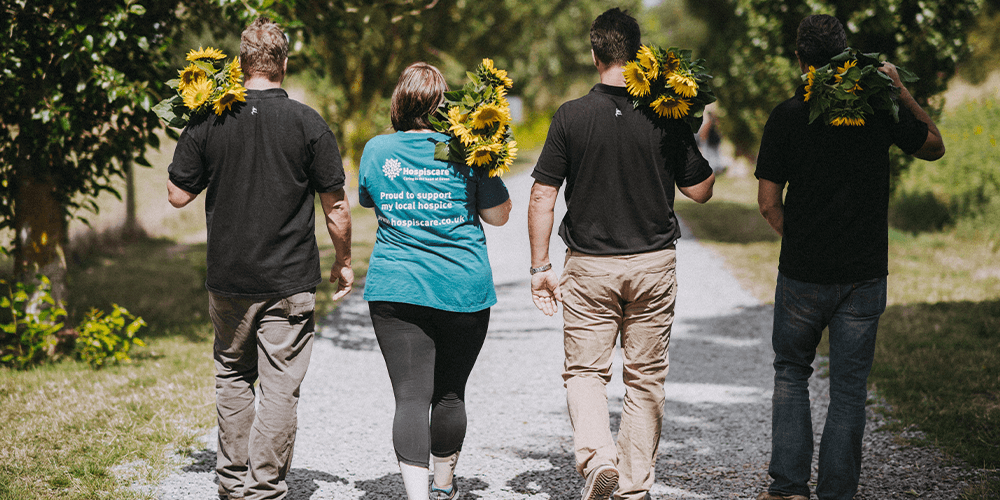
The Money You raised for Hospiscare
By picking, you've supported local flowers and local charity!
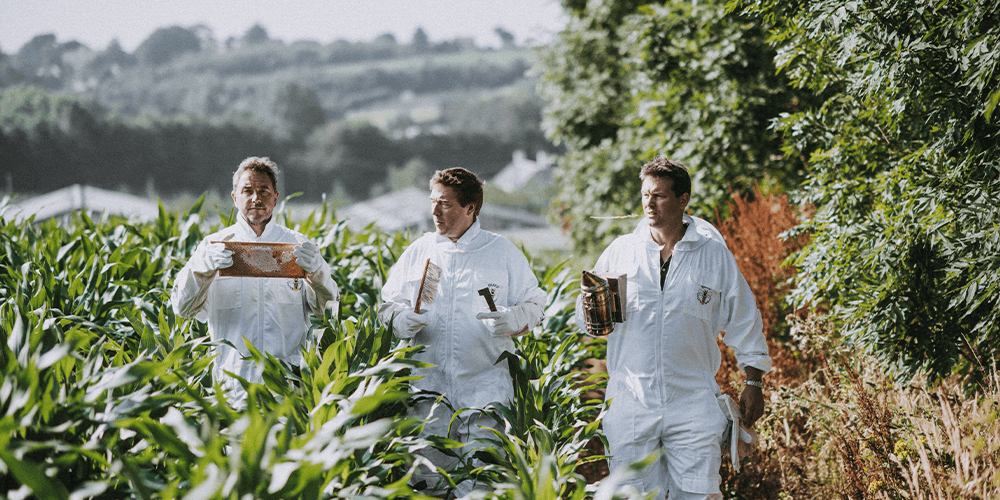
Raw Honey now available!
A super exciting announcement!

